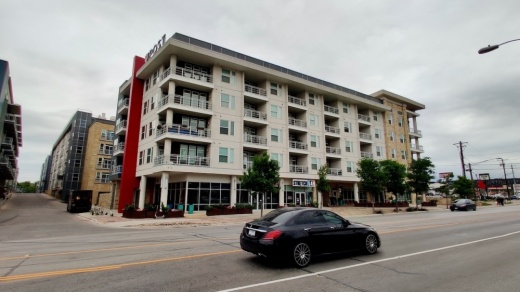An expansion of Austin's vertical mixed-use development program is likely on hold for at least one month.
The vertical mixed-use, or VMU, program has resulted in the construction of nearly 6,800 apartments and condominiums, according to city information as of April 18. The zoning designation applies only to select properties along Austin's transit corridors and highways, such as Lamar and Airport boulevards, Burnet Road, South Congress Avenue and I-35, and is based around a trade-off of building height for affordable housing.
Today, around 10% of VMU housing units are set aside for those earning lower incomes. Looking ahead, more than 8,900 housing units are planned or already under construction under the VMU label, 1,190 of which would be available at an affordable rate. Between the 73 existing or planned VMU developments, 97% of housing units created are rentals. "It’s not a huge program, and it's certainly not the only thing we should be doing, but that’s a successful program in my mind. If we can generate more units as well as more affordable units by allowing additional height, then I think that’s important to do," District 5 Council Member Ann Kitchen said in an interview.
The proposed code update, VMU2, would grant up to 30 feet of additional building height while keeping current VMU rules unchanged. If developers choose to build under VMU2, extra height would be exchanged for more affordable spaces available at even lower rates.
A Kitchen resolution launching the VMU2 code update was unanimously approved by council last fall, and a finalized code proposal passed through the planning commission last month. While scheduled for a council vote on April 21, that decision will be pushed off to late spring after an April 19 work session revealed some officials' desire for more fine-tuning and community discussions on the topic.
VMU2 emerged last fall from council talks aimed at addressing Austin's housing crisis and working around a stalled land development code update. The proposal proved to be one of the less controversial housing policies council has taken on in recent years given consensus both in the community and at City Hall that denser development belongs along major corridors.
"The kinds of changes that are happening in our city with Project Connect, and also with our transit in general, are game-changers. And it’s important that everybody be able to take advantage of that. So that means our folks with lower income need to be able to live on transit corridors," Kitchen said. "I want to see more opportunity on these transit lines, for people to live there."
Closer review
Ahead of council's April work session, District 4 Council Member Chito Vela announced his intention to amend the VMU2 measure by exempting new development from compatibility and parking requirements set by existing city code. Vela said he proposed the compatibility change based on city staff findings that, even with an expanded bonus program, only around one-third of VMU-zoned properties could actually build to their allowed heights given conflicts with the development limits already in place.
That plan pushed council to weigh whether officials should pass VMU2 this month and deal with other topics, such as parking and compatibility, later. The question of property owner notice and protest rights—which sunk Austin's yearslong bid to rewrite its land development code—also came into play, with officials uncertain of how a March ruling against the city's past process might affect the VMU2 change.
Under Texas law, owners of property near a site that is up for rezoning must be notified of the proposed change and allowed to protest it. A protest by more than 20% of eligible landowners then requires a higher threshold to pass City Council; in Austin, that is at least nine of 11 total votes.
In line with that requirement, Mayor Steve Adler last year called on council members to focus only on housing proposals that at least nine members agree on, one of which was VMU2. However, officials this month were concerned over how the city's recent defeat in court could affect the bonus program's passage.
According to city legal staff, the format of the VMU2 update may open the door to widespread protests given the more than 800 sites now zoned as VMU across nearly every City Council district. An amendment from Kitchen, if approved, would close the door to immediate challenges—although any property that seeks the VMU2 label in the future would be subject to protest.
Planning for a vote
While not every council member was fully supportive of a VMU2 delay, some officials said more planning time will allow the code revision and related issues to come back in a better form. Still, several also noted a need to move with urgency on the program update and other policies in the face of skyrocketing rents and home prices in the city.
"This ordinance won’t be the silver bullet, but I think passing it with Council Member Vela’s amendments would signal that we’re finally ready to take some action to respond to consensus thought on density, also while reimagining some of the outdated rules that have led to our current crisis," District 1 Council Member Natasha Harper-Madison said. "I’m not sure what the value is in postponing so we can have more discussion and more input. I think we’ve done that for the past decade."
Vela said after the work session that he was encouraged by council's willingness to dive into more controversial issues, such as compatibility, while working toward VMU2's passage in the near term. Despite the expected delay this week, the code amendment is still in line to pass in some form before council's summer recess. Adler said another discussion of the proposal will likely be held in mid-May, and a final vote on the code change could follow in June.





